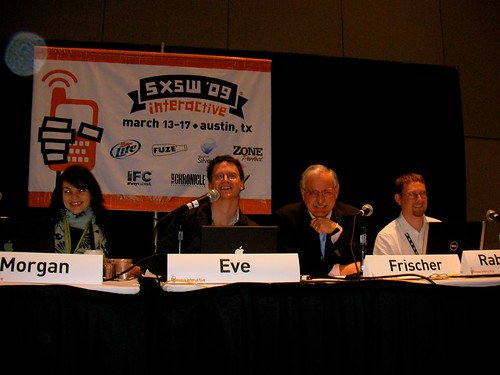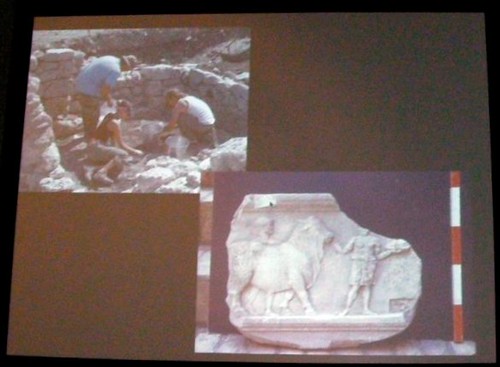SXSWi 2009: The Real Technology of Indiana Jones
Last March I went to SXSWi 2009. I posted the notes from two of the days, but conference exhaustion got in the way of me posting the notes from the last three days. After much delay, here they are.
The Real Technology of Indiana Jones – Room B
Monday, March 16th
11:30 am – 12:30 pm
Archaeologists no longer rely on whips and fedoras; they now use a range of sophisticated digital tools to collect information in the field and study it in the lab. Too often, though, this wealth of information meets the same fate as Indy’s discoveries, locked away in digital ‘warehouses’ where no one can see it. The archaeologists on this panel present different projects that use web platforms and open-source approaches to bring digital archaeology out of the warehouse and into the public eye. Learn how archaeologists are using interactive media to open their data and processes to the public; discuss the creation of an online archaeological community in Second Life; and explore ancient cities across space and time using publicly-available online tools.
Colleen Morgan: Archaeologist, UC Berkeley
Stuart Eve: Dir, L-P Archaeology/UCL
Bernard Frischer: Rome Reborn
Moderator: Adam Rabinowitz: Asst Professor, University of Texas at Austin
Adam Rabinowitz:
The REAL technology is the trowel. What we are talking about the ways in which the web can help engage the public with archaeology.
There is a media image of archaeology. He solves puzzles to find a treasure. This isn’t really the way it happens. The process of archaeology is more boring a MUCH more collaborative.
What is the coolest thing you’ve found?
See that broken spot there? I did that with a pickaxe. It was carved in the Roman period, but it was used as a gravestone. There is a story behind it, but you never see the story in the museum.
Most of everything is just in a huge warehouse. The web is making things better.
We can use Google Earth to show what is lost in the warehouses.
Most of it is object based. We are trying to talk about context.
Archaeology is process and it has its own context as well.
Stuart Eve:
Adam is more of an Indiana Jones than I am.
In London, it’s usually happens as part of the planning prcess to make sure that when a building is built they have to have the archaeologists clear the site.In Europe, there is a lot of archaeology. It took us six months of digging before we could give them clearance.
Archaeology is DESTRUCTION. We have quite a responsiblity to save it in the right way.
My best find ever? A set of Roman latrine pits.
The community is interested. The local schools show up to watch us work. We have quite a few different audiences. We try to make a website to share the information with people.
Once we finished the six months of excavation, it takes a long time to publish the information in a book, so we have been posting thing online just so people can see it earlier.
We are still using semitransparent paper to mark where things were. Low tech and could be better. There is also information on a relational database.
We also have plans and photos. We georeference the photos and then put it in a plan that is put in the composite site.
There are also Site Notebooks. Instead of that now, we have blogs (journals). For archaeologists, this is a REALLY big thing. The people who are digging up the archaeology is actually much more involved now.
Videography: Made a bunch of video podcast on iTunes.
We use an open source database system. It’s called ARK (ark.lparchaeology.com). The photos are on Flickr and they make charts as well.
ARK – transclusion: The information can be put into another person’s blog.
This is all a big experiment for us.
Colleen Morgan:
Businesses are abandoning Second Life. The non-profits are moving in. We find it useful. Second Life is dead? GREAT! We like dead things.
Distributed Outreach incorporates Traditional Outreach. It has more portable content.
The took a pot that has been around since the 1950s. They used Comic Life to make it more accessible.
They also used Comic Life to explain the archaeology process. The people are usually not included in the formal archive, so we’ve been experimenting with more photos.
We’ve also been using Flickr notes. Being able to annotate photos really helps teach the lay public archaeology.
Catalhoyuk: is a 9000 years old site www.middlesavagery.wordpress.com
Two years of excavating, she was asked to recreate a room in Second Life. There are a whole bunch of houses in Second Life. When you recreate them, it makes you think about different things.
They burned it down because they had evidence that it had burned.
Reconstructive Machinimas Recreate the past with Second Life. No non-player character in the recreation. We’ve asked students to pretend that they are a person in the place.
Second Life is not perfect, but placing the recreation there has been AMAZING. People come across this. It’s archaeology out in the open. It gives them serious insights into living during that time.You don’t get that in essays.
Bernard Frischer:
Rome Reborn on Google Earth
They use CAD and 3D modeling.
Interpretation: handheld, Google Earth
James Madison’s Montepelier home
Digital techonology can replace the guided and self guided tour.
Edutainment 3D Ancient Rome populated with cartoon-like figures. It was in Forbes Magazine.
Time Machine
Google Earth can give a self-guided tour. On Rome Reborn
Ruth Tringham: on Second Life also answering questions.
Scholars find gaps in information. We tend to gloss over and forget about where the gaps are. The modeling process helps scholars make discoveries. Once you have a model, you can use it for making discoveries as well. If you could put all the work of all the scholars in one city. You can see how all the points relate to each other.
With Rome Reborn: They realized the Trajan built his column could be seen from various places that we never noticed that it might work that way.
Question: Rose Theater was preserved. When you remove the archaeology, what are you missing? Does a little bit of you die inside?
Stuart Eve:
One hotel actually changed their plans so they could preserve a Roman wall.
We destroy things when we do our work. By giving the excavator a voice, you actually preserve more of an archive.
But basically, the hotels have got to go up.
Question: 90% of the data never makes it to the public. You are sitting in the living room of that first school teacher in the area.
Adam Rabinowitz:
This really helps us how we perceive the past. That’s a great thing to point out.
Colleen Morgan:
How would we have known that already? We really need options for embedded archaeological information so we know that when we walk in a place.
Question: What about multiple interpretations?
Bernard Frischer:
Technology has changed the how we believe. There is less attacking. We’re in a more colloborative mode that works. There are ways to show both views.
Ruth Tringham:
Multiple interprestations in archaeology. It’s very important to be able to share with the public transparency of how we create 3D models.
When we deal with historical buildings that are gone, our interpretations are FILLED with ambiguity. It’s nice to be able to share our details of our indecision about this.
Colleen Morgan:
In SL, there is authorship. You can SEE who made the interpretation and you can even put the percentage of surety.


